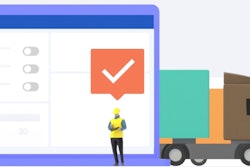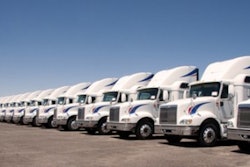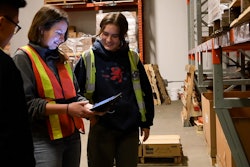
While many believe that the COVID-19 pandemic is responsible for pioneering the digital supply chain age, what many don’t know is that digital transformation in some form dates back to the 1940s.
Claude Shannon, dubbed the founder of modern digital communications theory, paved the way for digitalization with his philosophy on how an information source, a transmitter, a channel, a receiver and a destination together form the basic elements of communication.
It’s these basic elements that still to this day make up the complete form of communication, digitally connecting people, product and plants.
And, while digitization means different things to different companies, a digital supply chain presents the same benefits across the board in moving temperature-controlled foods in a safe and efficient manner.
“In the cold food chain, a connected digital supply chain helps companies determine potential threats to the business and product, determine hazard origins through tracing, accurately forecast demand to minimize waste and optimize inventory, and continue to ensure only the best product makes its way to the consumers,” says Jacob Olson, director, manufacturing solutions, Cleo.
“For the food/cold food chain industry, digitizing the supply chain means more accurate demand sensing and fulfillment, reduced food wastage, fewer and faster trips through optimized logistics and more,” adds Prashant Agrawal, founder and CEO, Impact Analytics.
A digital supply chain also closes the gap to enhance visibility, build resiliency and mitigate risk along the way. That’s because it provides that complete view of everything from farm (raw material) to fork (grocery story/foodservice establishment).
“Digital supply chains are very complex. They’re designed to offer a complete view of everything that needs to happen to create food, from raw material traceability and management (including land usage, animal usage, etc.) to packaged goods production facilities to B2C traceability of consumption, inventory and stocking management. Organizations must consider all these factors to get every piece of a (sometimes) international supply chain right and enable traceability and sustainability tracking, all while ensuring that logistics, demand planning and forecasting, etc. are integrated, interconnected and driving toward common goals,” says James Newman, head of product and portfolio marketing at Augury. “For the cold food chain in particular, this becomes even more interesting when we consider things like energy costs for refrigeration, transportation costs (including refrigeration) and production costs for creating and storing refrigerated foods.”
At its core, a digital supply chain is a series of process automations that relieves humans of the responsibility to micromanage, adds Chirag Modi, corporate VP, industry strategy, supply chain execution, Blue Yonder.
“It allows professionals to make decisions based on digital information and with complete confidence the information is accurate. Digital supply chains have been a game-changer for cold food chains, particularly since the start of the COVID-19 pandemic. Food manufacturers and retailers have heavily invested in digital tools that optimize visibility and efficiency. Expiration dates are top-of-mind for cold food professionals, and with digital supply chains they can monitor their warehouses and distribution networks like never before,” he adds.
The digital supply chain also means collecting, organizing, and using data in electronic format, accounting for things such as visibility, collaboration and credibility, according to Igor Rikalo, president and COO at o9 Solutions.
“At its most basic level, digitization means paper transactions or verbal communications are captured and used electronically. This would encompass cloud infrastructure, laptops, mobile devices, etc. Basically, you're taking something managed by paper or instructed by voice and making it electronic,” adds Rikalo. “[It] means you get efficiency and performance improvement and can make better decisions. Digitization is a distinct business advantage for food and logistics, where the lead time and shelf life can be short, and decisions must be made quickly. It means you can make better decisions faster, your route to market is quicker, and you have less waste.”
Post-pandemic, a digital supply chain is more about transforming the many manual processes into a more automated fashion, likens Mike Bush, chief growth officer of CDL 1000.
“Let’s call this ‘Digitization Phase 1.’ For instance, we’re able to identify a malfunction in a reefer truck’s cooling system in real-time, which can mean deploying a second vehicle to rescue the goods before they’ve been stored at the wrong temperature (and saving the value of the goods by avoiding spoilage), and sending a repair service to fix the failing reefer unit so the driver doesn’t spend a day on the side of the road,” Bush adds.
 Post-pandemic, a digital supply chain is more about transforming the many manual processes into a more automated fashion.CDL 1000
Post-pandemic, a digital supply chain is more about transforming the many manual processes into a more automated fashion.CDL 1000
In order for any type of Phase 1 to begin though, companies within the supply chain space need to invest in technologies designed to better automate processes, both in the plant and on the road.
One particular area that has seen significant benefit from the introduction of digital management platforms has been the sourcing, buying and selling of pallets, says John Vaccaro, president, Bettaway Supply Chain Services and founder, PalletTrader.
“PalletTrader, launched last year, is a neutral, online platform, open to all, that digitizes the process of finding, sourcing, negotiating, buying, selling, settling and arranging transportation of pallets,” Vaccaro says. “PalletTrader has reimagined with technology how pallets sales are transacted, bringing a common, e-commerce-like platform and process that is streamlining the process and delivering value to thousands of pallet buyers and sellers.”
Another topic impacting the adoption of digitization is the continued use of automation and how to leverage artificial intelligence (AI) and digital twins as they specifically relate to supply and demand planning, says Casey Jenkins, owner, Eight Twenty-Eight Consulting LLC.
“Essentially digital twins are modeling tools that create replicas of a supply chain (or twin) to be able to test ‘what-if’-type scenarios. In other words, it allows modeling of outcomes to test different actions, approaches, or potential risks to see the consequences; both positive and negative,” says Jenkins. “It’s important for companies to keep in mind though that these are simply tools that can be leveraged. Even AI needs some oversight until we’re able to understand it better and how to use it effectively within our operations.”
It's the leverage that has many in the supply chain turning to other technologies such as smart sensors, robotics, cloud-based solutions, smart labels and smart packaging, machine learning and GPS tracking, among others; basically any technology that produces data that can be measured, tracked and used to tell a story behind the journey of certain temperature-controlled foods.
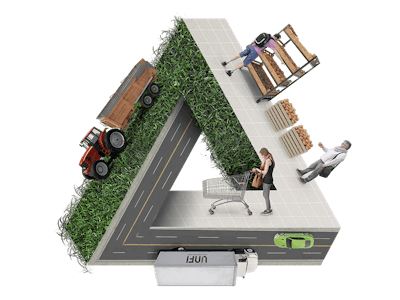 Digital transformation doesn’t have to be done entirely alone.Crisp
Digital transformation doesn’t have to be done entirely alone.Crisp
However, factors such as capacity planning and demand forecasting pose challenges to some supply chain companies, but leveraging any kind of emerging technology may present the resolutions needed to keep product moving.
“This challenge can arise because, often, companies rely on week- or month-old inventory reports to determine, ‘Do we have space for this?’ But, when you have up-to-date data, you can use it to make recommendations on how to optimize the space that you have, and how much product you can take on. For example, if, thanks to real-time reporting, you know your capacity up to the moment, it becomes much easier to decide: ‘Can we transfer products from one facility to the other?’ Or, if you are a 3PL, to decide, ‘Can we help a new client out based on their requirements?’ Effective capacity planning boosts efficiency and helps to ensure product integrity,” says Kaitlin Mercier, VP of partnerships, Routeique. “Once this baseline is established for the network, then you can start to leverage AI to solve problems that rely on having good-quality data.”
Sometimes, that digital supply chain goes beyond the traditional warehouse management system (WMS) and in some cases even the warehouse execution system (WES). That’s why some companies are venturing into a combined WMS/WES, as well as manufacturing execution systems (MES) “to provide visibility into item location and quantity throughout the manufacturing process, which they do not receive with just the MES,” says Christian Nixel, senior director of technology, enVista Corp. “There is also a lot of opportunity for robotics and MHE to increase the effectiveness, efficiency and timeliness of the movement of goods in the warehouse.”
Other technologies such as Internet of Things (IoT) and blockchain enable what’s dubbed the "smart cold chain,” which predicts environmental disruptions, raises real-time alerts and even self-corrects, says Agrawal.
“There is also digital collaboration via virtual situation rooms that connect suppliers, distributors and retailers to facilitate better decisions faster and advancements in AI demand forecasting to predict hourly demand and maximize the shelf-life management, including intraday markdowns of fresh and prepared foods and the reduction of waste and spoilage. Finally, there are last-mile innovations focused on the cold chain to ensure that shoppers receive undamaged and fresh product regardless of the buying channel,” adds Agrawal.
Starting the digitalization journey
From food production to the retail and/or foodservice outlet, the digital supply chain helps to transform the way food is moved from Point A to Point B. But, for many companies still relying on the good ‘ole pen-and-paper method, starting the digitalization journey can be intimidating, cumbersome and costly depending on how deep the digital supply chain goes.
 Digital transformation will require new ways of thinking and focused change management.DHL Supply Chain
Digital transformation will require new ways of thinking and focused change management.DHL Supply Chain
However, it all starts with one thing, and that’s determining the largest blockers the business is facing.
“Often, digital projects start as ‘proof an idea’ rather than ‘can we solve a problem for the business.’ As a result, numerous research studies and analyst groups agree that 75-85% of all digital projects get stuck in pilot mode, and they are never able to scale across an enterprise. In many cases, that is a direct result of not being able to translate the pilot results into an achievable business outcome at scale,” says Newman. “If the issue is to solve raw material availability due to waste, look at where that is happening in the supply chain, what you are doing today and what success looks like for the entire business if you eradicate this issue. Then, focus on a technology selection process that can address and realize the actual core business need. Many times, this means foregoing the idea of generic platforms that could potentially solve numerous challenges someday and instead focusing on purpose-built solutions that can immediately tackle the problem they were designed to solve and have already cracked the scalability issue.”
“Many organizations and consultants talk about starting small with digital projects, but in reality, this has led to many bad practices. The best companies don’t start small. They start smart with a real focus on what the global outcomes to be realized are and then choose digital solutions that meet those requirements,” he adds. “This methodology doesn’t care where in the supply chain you start, whether it’s in raw material handling, finished product loss and waste improvement, or raw materials to finished product processing. But it does require the business to take a hard look at what is really driving the need for change and be willing to tackle that problem head on, very specifically.”
For others, it’s about starting from the bottom-up.
“Companies can start with something as simple as KPI tracking. Once you define success for each step of the supply chain, you can begin improving your processes. From there, map out the entire supply chain—the production, the handling, the distribution, the storage—and try to automate every aspect through technology. This iterative approach is a good way to get started. Once companies have a baseline established, they might consider more top-down solutions like warehouse or transportation management platforms. These full-scope tools will help track and improve every step of the supply chain,” says Modi.
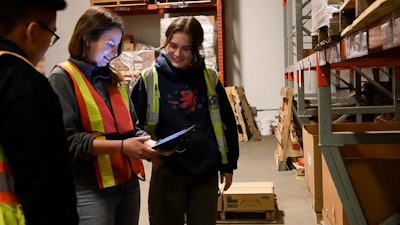 Leveraging any kind of emerging technology may present the resolutions needed to keep product moving.Routique
Leveraging any kind of emerging technology may present the resolutions needed to keep product moving.Routique
Another starting point is simply looking at the data.
“In analytics, the saying is ‘garbage in, garbage out.’ If the data you’re building models on is unreliable, the insights of the model will be unreliable. For the supply chain, which starts with understanding what metrics are most critical to the firm and what data is needed to drive those metrics. Compare what data is available to what data is needed, and gaps start to appear in what data is necessary to measure performance,” says Barry Bradley, head of supply chain, Crisp.
Case in point: Digital transformation will require new ways of thinking and focused change management, according to Omer Rashid, VP, Ops Ex, automation, innovation, analytics for DHL Supply Chain.
“The first thing needed is to define your digital strategy. Once you have determined what you are trying to achieve (whether that is reduced costs, improved lead times, more accurate inventories, fresher product, etc.) that will guide your approach and solutions,” Rashid says. “Then I would suggest a practical approach. Dip your toe in to get comfortable with solutions that you know can scale, understand value propositions and develop talent that can harness the technology while continuing to execute.”
Just like any new problem-solving journey, it’s also important to understand the problems before looking at solutions.
“It’s easy to fall in love with a tool that doesn’t end up meeting your needs. Once you define the problems, look for solutions. That doesn’t have to mean a new tech stack; you can add functionality without replacing everything. Partner with IT and sourcing using a balanced scorecard and include users in the evaluation process. Talk to experts who aren’t trying to actively sell you something,” says Hillary Drake, CEO and co-founder of Liminal Network. “The trend I’m most excited and worried about is data availability and its partner analysis paralysis. We’re all analysts now. It’s not enough to have a carrier-level, on-time service; we need to understand on time in full for a single customer or product, and we need to be able to fix it. Building the right data architecture is crucial. That can mean partnering with IT or bringing an analyst onto the team, but you as the business expert must drive it. Don’t expect IT to know what you need. At the same time decisions must be made. Don’t get hung up on best when good enough will satisfy your customer now.”
Another way to look at it is to measure the percentage of a supply chain that is not digital, Rikalo says.
“The more manual the activities, the more impact digitization will have. This impact can either be through internal improvement possibilities or the effect of competitors becoming more digital and gaining efficiency advantages,” Rikalo adds.
It’s also best to understand (and acknowledge) that no digital supply chain solution solves all problems, says Alex Haar, chief product officer, Parsyl.
“When looking into digital supply chains, one potential pitfall is using tools that operate in a data silo, where the data is effectively trapped within that single solution. Finding a solution that interoperates easily with other products is critical,” Haar adds. “For example, companies who have a traceability solution that helps them comply with food safety laws will want to share their traceability data across other systems as well, such as their temperature monitoring solution and their ERP. Now more than ever it is critical that digital solutions play well with others.”
On the bright side, when it comes to digitization, Busy says, “the path of least resistance is the path of most likely success. Companies should start by identifying a specific issue they want to solve, then trying a solution to the issue, tracking the results, and then adding another issue once the first solution has proven successful.”
What’s more is, the real hurdle to adopting a digital supply chain is in fact the digital execution, says Ron Lee, chief product and marketing officer, 3G.
“There’s a ton of data out there, but much remains unusable because of a lack of connectivity. The most significant challenge in supply chains is creating, managing and maintaining the channels through which data flows between systems. I’ve always advocated for a dual approach: develop modular systems with that connectivity built in and prioritize strengthening the links between systems that require constant communication,” he adds. “Another misconception is that digital solutions are ‘plug-and-play’ or ‘set it and forget it.’ On the contrary, maintaining connectivity, which makes it all work, takes consistent work.”
Another challenge with digital supply chains is speed.
“Consumers have an appetite for faster and faster delivery, especially from their local grocery retailers. Businesses will have to increasingly rely on technology and automation to meet this demand,” says Modi. “In some global regions like APAC, delivery is often achieved in 30 minutes or less, and I think we might see demand for that type of efficiency in North America. Speed is also a factor in the digital platforms themselves. Customers are demanding simple tools that only require, say, three steps or fewer to place an order. We have the technology to meet this demand for speed; it’s a matter of leveraging the right tools and training food professionals to use them.”
Digitalization is here
Regardless of where you are in the journey to digitalization, or if the decision to go digital is even in existence, one thing is for certain – digital supply chains are here.
“Companies should embrace digital technologies, otherwise, they run the risk being left behind,” Rashid says.
And, digital transformation doesn’t have to be done entirely alone.
“Plenty of great software and supply chain solutions can be brought in to accelerate the transformation. Creating a digital transformation team and building all the in-house solutions has a huge opportunity cost. Each organization needs to understand what pieces they will build, and where they will partner with experts,” says Bradley.
Adopting a digital supply chain also doesn’t need to happen all at once.
“For example, you can’t go from using spreadsheets to using full automation in one initiative,” Jenkins says. “That’s setting yourself up for failure. Instead, approaching digital transformation with a realistic perspective will help to embrace the change. It’s being realistic about where your company is at, where your knowledge base around these concepts are at and having expectations that there will be some bumps in the road along the way. Small changes and steps forward are still steps forward.”
“It's also important to note that the only way a true digital transformation can occur is if all parties of the supply chain are approaching business-to-business interactions as a partnership” Jenkins adds. “There has to be a level of trust and security with data and information flows so that there is true visibility and collaboration.”
And, you don’t need new top-tier systems to achieve real improvements, Drake adds.
“Dig into the data that already exists on your POs and invoices, leverage your CRM and OMS, and look at tools that bolt onto existing systems vs. replacing everything at once. Finally, don’t customize. It’s easier in the short term to keep everything the way you’ve already done it, but in the long term, customization leads to expense and frustration. In supply chain, we all use similar processes and there are off-the-shelf tools that will exceed your needs.”
What’s more, because every day presents a new supply chain disruption of some kind, integrating multiple systems will become more prevalent in the digital supply chain world, according to Nixel.
“With so many available systems and an ever-expanding technology field, more integration frameworks are becoming necessary to enable multiple systems in the same supply chain to communicate with each other when moving product through every process. It is becoming more common to add an interface layer that can act as the communicator between any two systems. This is a really effective way to reduce the complexity involved in maintaining integration even in the most complex technology environments,” Nixel says. “As digital supply chains become more complex, we’re starting to see systems function at higher levels than they were traditionally designed for. Many systems are branching out into more and more functionality to be able to provide more value to each customer.”
 Food shippers that leverage today’s emerging technologies are better positioned to unlock better control and visibility over the entire lifecycle of shipments.Uber Freight
Food shippers that leverage today’s emerging technologies are better positioned to unlock better control and visibility over the entire lifecycle of shipments.Uber Freight
However, going fully digital doesn’t mean you lose the human aspect to the supply chain.
“When transforming your supply chain, the human aspect is crucial,” adds Brenig-Jones. “Focusing on training, managing changes and promoting constant improvement leads to long-term success. It's equally important to seamlessly integrate supply chain systems with other business functions for increased efficiency and data accuracy. Staying updated with industry changes and new technologies is essential for competitiveness. In short, focusing on technology, processes, and training will help improve your supply chain in the long run.”
Plus, food shippers that leverage today’s emerging technologies are better positioned to unlock better control and visibility over the entire lifecycle of shipments, says Armon Shahpar, senior lead, enterprise partnerships, Uber Freight.
“This includes everything from real-time pricing and procurement tools, facility insights to solve for warehouse inefficiencies, and tracking capabilities to ensure shipments get from Point A to Point B. We also take a holistic approach to optimize our customers' supply chains, consulting with global food companies, beverage distributors and food shippers to spur millions in cost savings, reduce greenhouse gas emissions and ultimately provide them with actionable tools to get goods delivered with ease and on time,” Shahpar says.
At the end of the day though, going digital isn’t just about the technology. For many companies, it’s about “your team's ability to take action based on what the data says and make proactive decisions,” says Haar. “Teams will need to balance a robust feature set with ease of use, ability to customize and the ability to customize to their organization’s unique needs.”





